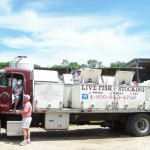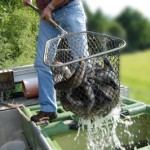Body condition scores (BCS) are an excellent means of monitoring the effectiveness of your beef-cow-nutrition program. Here are 10
management tips to help ensure your cows are at a target BCS of 6.0 by calving:
- Late summer-Evaluate your cows while still on grass. If they score thin to borderline moderate during this time and forage availability is still sufficient, provide a balanced protein and energy supplement to improve forage intake and increase forage digestibility.
- Weaning season-Sort cows by body condition and age. Feed according to target body condition scores desired by calving.
- Late lactation (2 months prior to weaning)-Depending upon current forage availability, supplementation and/or a modified weaning strategy may be necessary. Wean thin cows.
- Weaning-Pay particular attention to young cows weaning their first calf and cows beyond their prime age. They are most likely to be thin at this time.
- 100 days before calving-This is the last opportunity to gain body condition and is a good time to separate thin cows from cows in good condition and increase feed to thin cows.
- Calving-Thin cows are an indication that a change in the feeding program is needed.
- Breeding season-If cows are thin, additional supplementation and/or implementation of an early weaning strategy may be necessary.
- Feedstuffs-Always ensure availability of quality feedstuffs containing ample nutrient levels to meet elevated nutrient requirements of cows during important production periods.
- BCS fluctuation-Be aware that cow body condition ebbs and flows over time in relation to productivity and climatic conditions. Try to accurately evaluate the status of your cows’ BCS in relation to future levels necessary for key production periods.
- Supplements-Use supplement programs which correct for nutritional deficiencies and also complement and improve utilization of the base forage.
Good Nutrition Vital for Efficient Reproduction
Good nutrition is critical for efficient reproduction in cow-calf enterprises. Most reproductive failures in beef cows, for example, can be attributed to improper nutrition resulting in thin body condition. The cow’s priorities for nutrition are maintenance, lactation, growth and reproduction. The nutrition level pre- and post-calving affects the conception rate of subsequent breeding seasons. Cows that are thin prior to calving will have a delayed onset of estrus. Thin cows after calving will have reduced conception rates.
Obesity is a problem in heifers that become fat during the growing phase. Fat heifers normally have lower than average reproductive rates. Immature cows continue to grow until approximately 4 years of age. These young cows should be maintained through the yearly cycle about one body condition score (BCS) higher than mature cows to achieve the same reproductive performance.
Monitor the effectiveness of your nutrition program in the long-term by herd performance records. But, to deal with your present situation in the short term, pay close attention to the BCS of your cows.
According to information from the Minnesota University Extension Service, research has shown that each 10 percent of body weight lost before calving can result in a delay of the first heat period by 19 additional days. Cows too thin at calving take longer to recover and to start cycling for re-breeding. These cows will have lower conception rates than cows in moderate to good condition at calving. It is important to bring thin cows into condition as soon as possible to improve the odds of success at the start of the breeding season.
Dividing the cow herd into two groups according to nutritional needs, and feeding them accordingly, can have a positive impact on re-breeding success.
Bull Nutrition
Nutrition also is important for the reproductive efficiency of breeding bulls. Management of bulls includes the following three phases:
- Before breeding season – Nutrition prior to the breeding season is important as bulls will tend to lose weight during the season.
- Yearling bulls – Should be growing adequately and maintaining satisfactory body condition without becoming excessively fat. This will require between 25 and 30 pounds of dry matter from a ration that is about 80 percent high quality forage and 20 percent concentrate. A 12 percent to 14 percent protein ration is needed. In many cases, a complete feed that will put bulls in good rigor without over conditioning them is preferred.
- 2 year old bulls – Are already at most of their mature size, so their ration is not quite as crucial. Approximately 30 to 35 pounds of a ration consisting of high quality forage and 5 pounds of grain should meet their needs.
- Mature bulls – The nutrition program should be based on physical condition of the bulls at the start of the conditioning period. If they have wintered well, a high quality forage plus 5 to 7 pounds of grain will build the necessary energy reserves.
Bulls should be evaluated and separated into two groups as they come out of pastures. Those in good condition that need no special care should be placed in one group. They will usually do well on primarily roughage diet. Young bulls that are still growing, and thin mature bulls, should be placed together so their nutrient needs may be met with some supplemental feed. All bulls should have access to high quality minerals.
Purina Mills, LLC has feed products to meet the precise nutrient needs of both brood cows and breeding bulls. Your Purina representative can help you determine cow and bull nutrient needs and select the supplements to help meet the specific needs of your herd.
Purina Mills ®


